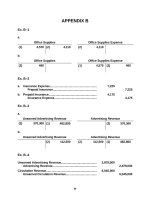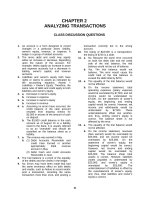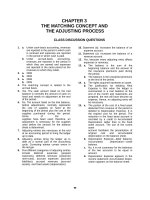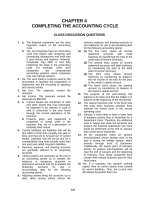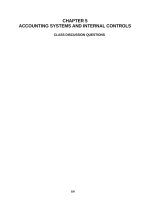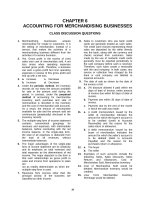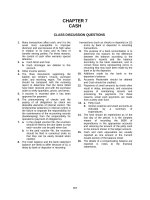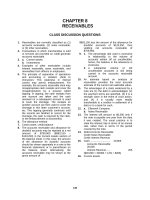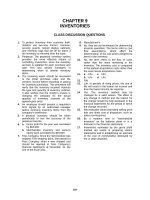Solution manual accounting 21e by warreni ch 17
Bạn đang xem bản rút gọn của tài liệu. Xem và tải ngay bản đầy đủ của tài liệu tại đây (247.29 KB, 52 trang )
CHAPTER 17
FINANCIAL STATEMENT ANALYSIS
CLASS DISCUSSION QUESTIONS
1. Horizontal analysis is the percentage
analysis of increases and decreases in
corresponding statements. The percent
change in the cash balances at the end of
the preceding year from the end of the
current year is an example. Vertical
analysis is the percentage analysis
showing the relationship of the component
parts to the total in a single statement. The
percent of cash as a portion of total assets
at the end of the current year is an
example.
2. Comparative
statements
provide
information as to changes between dates
or
periods.
Trends
indicated
by
comparisons may be far more significant
than the data for a single date or period.
3. Before this question can be answered, the
increase in net income should be
compared with changes in sales, expenses,
and assets devoted to the business for the
current year. The return on assets for both
periods should also be compared. If these
comparisons indicate favorable trends, the
operating performance has improved; if
not, the apparent favorable increase in net
income may be offset by unfavorable
trends in other areas.
4. You should first determine if the expense
amount in the base year (denominator) is
significant. A 100% or more increase of a
very small expense item may be of little
concern. However, if the expense amount in
the base year is significant, then over a
100% increase may require further
investigation.
5. Generally, the two ratios would be very
close, because most service businesses
sell services and hold very little inventory.
6. The amount of working capital and the
change in working capital are just two
indicators of the strength of the current
position. A comparison of the current ratio
and the quick ratio, along with the amount
of working capital, gives a better analysis of
the current position. Such a comparison
shows:
Current
Preceding
Year
Year
Working capital....... $42,500
$37,500
Current ratio............
2.0
2.5
Quick ratio...............
0.8
1.2
It is apparent that, although working capital
has increased, the current ratio has fallen
from 2.5 to 2.0, and the quick ratio has
fallen from 1.2 to 0.8.
7. The bulk of Wal-Mart sales are to final
customers that pay with credit cards or
cash. In either case, there is no accounts
receivable. Procter and Gamble, in
contrast, sells almost exclusively to other
businesses, such as Wal-Mart. Such sales
are “on account,” and thus, create accounts
receivable that must be collected. A recent
financial statement showed Wal-Mart’s
accounts receivable turning 109 times,
while Procter and Gamble’s turned only 13
times.
8. No, an accounts receivable turnover of 6
with sales on a n/30 basis is not
satisfactory. It indicates that accounts
receivable are collected, on the average, in
one-sixth of a year, or approximately 60
days from the date of sale. Assuming that
some customers pay within the 30-day
term, it indicates that other accounts are
running beyond 60 days. It is also possible
that there is a substantial amount of pastdue accounts of doubtful collectibility on
the books.
9. a. A high inventory turnover minimizes the
amount invested in inventories, thus
freeing funds for more advantageous
use. Storage costs, administrative
expenses, and losses caused by
obsolescence and adverse changes in
prices are also kept to a minimum.
b. Yes. The inventory turnover could be
high because the quantity of inventory
on hand is very low. This condition
might result in the lack of sufficient
goods on hand to meet sales orders.
3
c. Yes. The inventory turnover relates to
the “turnover” of inventory during the
year, while the number of days’ sales in
inventory relates to the amount of
inventory on hand at the end of the
year. Therefore, a business could have
a high inventory turnover for the year,
yet have a high number of days’ sales
in inventory at the end of the year.
10. The ratio of fixed assets to long-term
liabilities increased from 2 for the preceding
year to 2.5 for the current year, indicating
that the company is in a stronger position
now than in the preceding year to borrow
additional funds on a long-term basis.
11. a. Due to leverage, the rate on
stockholders’ equity will often be
greater than the rate on total assets.
This occurs because the amount
earned on assets acquired through the
use of funds provided by creditors
exceeds the interest charges paid to
creditors.
b. Higher. The concept of leverage applies
to preferred stock as well as debt. The
rate earned on common stockholders’
equity ordinarily exceeds the rate earned
on
total
stockholders’ equity because the amount
earned on assets acquired through the
use of funds provided by preferred
stockholders normally exceeds the
dividends paid to preferred stockholders.
12. The earnings per share in the preceding
year were $20 per share ($40/2), adjusted
for the stock split in the latest year.
13. A share of common stock is currently
selling at 10 times current annual earnings.
14. The dividend yield on common stock is a
measure of the rate of return to common
stockholders in terms of cash dividend
distributions.
Companies
in
growth
industries typically reinvest a significant
portion of the amount earned in common
stockholders’ equity to expand operations
rather than to return earnings to
stockholders in the form of cash dividends.
15. During periods when sales are increasing,
it is likely that a company will increase its
inventories and expand its plant. Such
situations frequently result in an increase in
current liabilities out of proportion to the
increase in current assets and thus lower
the current ratio.
4
EXERCISES
Ex. 17–1
a.
HOME-MATE APPLIANCE CO.
Comparative Income Statement
For the Years Ended December 31, 2006 and 2005
2006
Amount
Percent
Sales...........................................
Cost of goods sold....................
Gross profit................................
Selling expenses........................
Administrative expenses...........
Total operating expenses..........
Income from operations............
Income tax expense...................
Net income.................................
$500,000
275,000
$225,000
$ 90,000
60,000
$150,000
$ 75,000
25,000
$ 50,000
100.0%
55.0
45.0%
18.0%
12.0
30.0%
15.0%
5.0
10.0%
Amount
2005
Percent
$450,000
234,000
$216,000
$ 94,500
63,000
$157,500
$ 58,500
22,500
$ 36,000
100.0%
52.0
48 .0%
21.0%
14.0
35.0%
13.0%
5.0
8.0%
b. The vertical analysis indicates that the cost of goods sold as a percent of
sales increased by 3 percentage points (55% – 52%) between 2005 and 2006.
However, the selling expenses and administrative expenses improved by 5
percentage points. Thus, the net income as a percent of sales improved by 2
percentage points.
Ex. 17–2
a.
Speedway Motorsports, Inc.
Comparative Income Statement (in thousands of dollars)
For the Years Ended December 31, 2002 and 2001
2002
Revenues:
Admissions......................................
Event-related revenue.....................
NASCAR broadcasting revenue.....
Other operating revenue.................
Total revenues............................
Expenses and other:
Direct expense of events................
NASCAR purse and sanction fees.
Other direct expenses.....................
General and administrative.............
Total expenses and other..........
Income from continuing operations....
2001
$141,315
122,172
77,936
34,537
$375,960
37.6%
32.5
20.7
9.2
100.0%
$136,362
133,289
67,488
38,111
$375,250
36.3%
35.5
18.0
10.2
100.0%
$ 69,297
61,217
87,427
57,235
$275,176
$100,784
18.4%
16.3
23.3
15.2
73.2%
26.8%
$ 76,579
54,479
88,582
59,331
$278,971
$ 96,279
20.4%
14.5
23.6
15.8
74.3%
25.7%
b. While overall revenue did not change much between the two years, the overall
mix of revenue sources did change somewhat. The event-related revenues
(such as concessions) declined as a percent of total revenues by three
percentage points, while the percent of NASCAR broadcasting revenues to
total revenues increased by nearly three (2.7) percentage points. The
expenses as a percent of total revenues shifted the most between the direct
event expenses and NASCAR purse and sanction fees. That is, the direct
expenses as a percent of total revenues declined nearly two percentage
points, while the NASCAR purse and sanction fees as a percent of total
revenues increased by nearly two (1.8) percentage points. Overall, the income
from continuing operations increased a modest 1.1 percentage points of total
revenues between the two years, which is a favorable trend. As a further note,
the income from continuing operations as a percent of sales exceeds 25% in
both years, which is excellent. Apparently, owning and operating motor
speedways is a business that produces high operating profit margins.
Note to Instructors: The high operating margin is probably necessary to
compensate for the extensive investment in speedway assets. This is
confirmed by the rate of operating income return on total assets of nearly 9%.
Ex. 17–3
a.
HORIZON PUBLISHING COMPANY
Common-Size Income Statement
For the Year Ended December 31, 20—
Horizon
Publishing
Company
Amount
Percent
Sales................................................................
Sales returns and allowances........................
Net sales..........................................................
Cost of goods sold.........................................
Gross profit.....................................................
Selling expenses.............................................
Administrative expenses................................
Total operating expenses...............................
Operating income............................................
Other income...................................................
Other expense.................................................
Income before income tax..............................
Income tax expense........................................
Net income.......................................................
$ 1,414,000
14,000
$ 1,400,000
504,000
$ 896,000
$ 574,000
154,000
$ 728,000
$ 168,000
16,800
$ 184,800
23,800
$ 161,000
56,000
$ 105,000
101.0%
1.0
100.0%
36.0
64.0%
41.0%
11.0
52.0%
12.0%
1.2
13.2%
1.7
11.5%
4.0
7.5%
Publishing
Industry
Average
101.0%
1.0
100.0%
40.0
60.0%
39.0%
10.5
49.5%
10.5%
1.2
11.7%
1.7
10.0%
4.0
6.0%
b. The cost of goods sold is 4 percentage points lower than the industry
average, but the selling expenses and administrative expenses are 2.5
percentage points higher than the industry average. The combined impact is
for net income as a percent of sales to be 1.5 percentage points better than
the industry average. Apparently, the company is managing the cost of
publishing books better than the industry but has slightly higher selling and
administrative expenses relative to the industry. The cause of the higher
selling and administrative expenses as a percent of sales, relative to the
industry, can be investigated further.
Ex. 17–4
SANTA FE TILE COMPANY
Comparative Balance Sheet
December 31, 2006 and 2005
Amount
2006
Percent
Amount
2005
Percent
Current assets..............................
Property, plant, and equipment....
Intangible assets...........................
Total assets...................................
$260,000
500,000
40,000
$800,000
32.50%
62.50
5.00
100.00%
$200,000
450,000
50,000
$700,000
28.57%
64.29
7.14
100.00%
Current liabilities..........................
Long-term liabilities......................
Common stock..............................
Retained earnings.........................
Total liabilities and
stockholders’ equity...............
$170,000
210,000
50,000
370,000
21.25%
26.25
6.25
46.25
$150,000
200,000
50,000
300,000
21.43%
28.57
7.14
42.86
$800,000
100.00%
$700,000
100.00%
Ex. 17–5
a.
SCRIBE PAPER COMPANY
Comparative Income Statement
For the Years Ended December 31, 2006 and 2005
Sales...........................................
Cost of goods sold....................
Gross profit................................
Selling expenses........................
Administrative expenses...........
Total operating expenses..........
Income before income tax.........
Income tax expense...................
Net income.................................
2006
Amount
2005
Amount
$ 66,300
32,000
$ 34,300
$ 24,000
7,500
$ 31,500
$ 2,800
1,000
$ 1,800
$ 85,000
40,000
$ 45,000
$ 25,000
6,000
$ 31,000
$ 14,000
6,000
$ 8,000
Increase (Decrease)
Amount
Percent
$ (18,700)
(8,000)
$ (10,700)
$ (1,000)
1,500
$
500
$ (11,200)
(5,000)
$ (6,200)
– 22.00%
– 20.00%
– 23.78%
– 4.00%
25.00%
1.61%
– 80.00%
– 83.33%
– 77.50%
b. The net income for Scribe Paper Company decreased by approximately 77.5%
from 2005 to 2006. This decrease was the combined result of a decrease in
sales of 22% and higher expenses. The cost of goods sold decreased at a
slower rate than the decrease in sales, thus causing gross profit to decrease
more than the decrease in sales. In addition, selling and administrative
expenses increased by 1.61% between 2005 and 2006.
Ex. 17–6
a.
(1) Working capital = Current assets – Current liabilities
2006:
$875,000 – $250,000 = $625,000
2005:
$795,000 – $265,000 = $530,000
Current assets
Current liabilities
$875,000
= 3.5
2005:
$250,000
$795,000
= 3.0
$265,000
Quick assets
Current liabilities
$480,000
= 1.92
2005:
$250,000
$424,000
= 1.6
$265,000
(2) Current ratio =
2006:
(3) Quick ratio =
2006:
b. The liquidity of Marine Equipment has improved from the preceding year to
the current year. The working capital, current ratio, and quick ratio have all
increased. Most of these changes are the result of a decrease in current
liabilities, specifically accounts (notes) payable, combined with an increase in
the current assets.
Ex. 17–7
a.
(1) Current ratio =
Dec. 28, 2002:
(2) Quick ratio =
Dec. 28, 2002:
Current assets
Current liabilities
$6,413
= 1.06
$6,052
Dec. 28, 2001:
$5,853
= 1.17
$4,998
Dec. 28, 2001:
$3,791
= 0.76
$4,998
Quick assets
Current liabilities
$4,376
= 0.72
$6,052
b. The liquidity of PepsiCo has declined significantly over this time period. Both
the current and quick ratios have declined. The current ratio declined from
1.17 to 1.06, and the quick ratio declined from 0.76 to 0.72. Neither of these
declines is worrisome, however. PepsiCo is a strong company with ample
resources for meeting short-term obligations.
Ex. 17–8
a.
The working capital, current ratio, and quick ratio are calculated incorrectly.
The working capital and current ratio incorrectly include Goodwill as a part of
current assets. Goodwill is an intangible asset and is noncurrent. The quick
ratio has the correct numerator (quick assets) but does not include accrued
liabilities in the denominator. The denominator of the quick ratio should be
total current liabilities.
The correct calculations are as follows:
Working capital = Current assets – Current liabilities
$900,000 – $625,000 = $275,000
Current ratio =
Current assets
Current liabilities
$900,000
= 1.44
$625,000
Quick ratio =
Quick assets
Current liabilities
$275,000 + $123,000 + $172,000
= 0.912
$625,000
b. Unfortunately, the working capital, current ratio, and quick ratio are all below
the minimum threshold required by the bond indenture. This may require the
company to renegotiate the bond contract, including a possible unfavorable
change in the interest rate.
Ex. 17–9
a.
(1) Accounts receivable turnover:
Current year:
Net sales on account
Average monthly accounts receivable
$320,000
= 7.1
$45,070
Preceding year:
(2) Number of days' sales in receivables:
$300,000
= 6.5
$46,154
Accounts receivable, end of year
Average daily sales on account
$48,219
= 55.0 days
$877 1
$52,603
Preceding year:
= 64.0 days
$822 2
Current year:
1
$877 = $320,000 ÷ 365 days
2
$822 = $300,000 ÷ 365 days
b. The collection of accounts receivable has improved. This can be seen in both
the increase in accounts receivable turnover and the reduction in the
collection period. The credit terms require payment in 60 days. In the
previous period, the collection period exceeded these terms. However, the
company apparently became more aggressive in collecting accounts
receivable or more restrictive in granting credit to customers. Thus, in the
current period the collection period is within the credit terms of the company.
Ex. 17–10
a.
(1) Accounts receivable turnover:
Sears:
Net sales on account
Average accounts receivable
$35,698
= 1.2
($28,155 + $30,759) / 2
Federated:
$15,434
= 5.8
($2,379 + $2,945 ) / 2
(2) Number of days’ sales in receivables:
Accounts receivable, end of year
Average daily sales on account
$30,759
= 314.5 days
$97.8 1
$2,945
Federated:
= 69.6 days
$42.3 2
1
$97.8 = $35,698 ÷ 365 days
2
$42.3 = $15,434 ÷ 365 days
Sears:
b. Sears’ accounts receivable turnover is much less than Federated’s (1.2 for
Sears vs. 5.8 for Federated). Likewise, the number of days’ sales in
receivables is much greater for Sears than for Federated (314.4 days for Sears
vs. 69.6 days for Federated). These differences must be interpreted with care.
Sears has significant MasterCard receivables with customers who have not
made purchases from Sears, which represent receivables that do no
correspond to Sears’ sales. Thus, it is not surprising that Sears has a much
lower turnover than does Federated, since the accounts receivable include
receivables that are outside of the Sears retail network. In addition, we do not
know how much of the Sears or Federated sales are on credit; thus, it is not
possible to accurately compare the number of days’ sales in receivables with
credit terms.
Note to Instructors: The annual 10-K for Federated indicated that the sales
through its proprietary credit card was $4,128. Thus, the accounts receivable
turnover based on this number would be 1.6 ($4,128 ÷ $2,662), while the
number of days’ sales in receivables would be 260.6 days ($2,945 ÷ $11.3).
Thus, the calculations in part a. above actually overstate Federated’s
accounts receivable turnover and understates Federated’s credit card days’
sales in receivables. This exercise helps the student see the importance of
interpreting these ratios carefully. In the case of Sears, much of the
receivables are not related to Sears’ sales, which distorts the ratio. In the case
of Federated, only $4,128 million in sales were on account, thus actually
overstating its accounts receivable turnover and understating its days’ sales
in receivable, relative to the sales on account.
Ex. 17–11
a.
(1) Inventory turnover:
Cost of goods sold
Average inventory
2006:
$328,000
( $42,000 + $40,000 ) /2 = 8.0
2005:
$430,000
( $44,000 + $42,000 ) /2 = 10.0
(2) Number of days' sales in inventory:
2006:
2005:
1
2
Inventory, end of year
Average daily cost of goods sold
$40,000
= 44.49 days
$899 1
$42,000
= 35.65 days
$1,178 2
$899 = $328,000 ÷ 365 days
$1,178 = $430,000 ÷ 365 days
b. The inventory position of the business has deteriorated. The inventory
turnover has decreased, while the number of days’ sales in inventory has
increased. The sales volume has declined faster than the inventory has
declined, thus resulting in the deteriorating inventory position.
Ex. 17–12
a.
(1) Inventory turnover:
Cost of goods sold
Average inventory
Dell:
$29,055
( $278 + $306 ) /2 = 99.5
HP:
$34,573
( $5,204 + $5,797 ) /2 = 13.4
(2) Number of days' sales in inventory:
Inventory, end of year
Average daily cost of goods sold
$306
= 3.8 days
$79.6 1
$5,797
Hewlett Packard:
= 61.2 days
$94.7 2
1
$79.6 = $29,055 ÷ 365 days
2
$94.7 = $34,573 ÷ 365 days
Dell:
b. Dell has a much higher inventory turnover ratio than does HP (99.5 vs. 6.3 for
HP). Likewise, Dell has a much smaller number of days’ sales in inventory (3.8
days vs. 61.2 days for HP). These significant differences are a result of Dell’s
make-to-order strategy. Dell has successfully developed a manufacturing
process that is able to fill a customer order quickly. As a result, Dell does not
need to prebuild computers to inventory. HP, in contrast, prebuilds
computers, printers, and other equipment to be sold by retail stores and other
retail channels. In this industry, there is great obsolescence risk in holding
computers in inventory. New technology can make an inventory of computers
difficult to sell; therefore, inventory is costly and risky. Dell’s operating
strategy is considered revolutionary and is now being adopted by many both
in and out of the computer industry. Indeed, at the time of this writing, HP and
Gateway are changing their practices to mirror those of Dell. Apple Computer
also employs similar manufacturing techniques, and thus enjoys excellent
inventory efficiency.
Ex. 17–13
a.
Ratio of liabilities to stockholders’ equity:
Dec. 31, 2006:
b.
$1,350,000
= 0.54
$2,500,000
Number of times bond
interest charges were earned:
Total liabilities
Total stockholders' equity
Dec. 31, 2005:
$1,540,000
= 0.70
$2,200,000
Income before tax + Interest expense
Interest expense
Dec. 31, 2006:
$528,000 + $96,000 *
= 6.50
$96,000
Dec. 31, 2005:
$336,000 + $112,000 **
= 4.0
$112,000
*$1,200,000 × 8% = $96,000
**$1,400,000 × 8% = $112,000
c. Both the ratio of liabilities to stockholders’ equity and the number of times
bond interest charges were earned have improved significantly from 2005 to
2006. These results are the combined result of a larger income before taxes
and lower serial bonds payable in the year 2006 compared to 2005.
Ex. 17–14
a.
Ratio of liabilities to stockholders’ equity:
Hasbro Inc.:
Mattel Inc.:
Total liabilities
Total stockholders' equity
$2,016,115,000
= 1.49
$1,352,864,000
$2,802,103,000
= 1.61
$1,738,458,000
b.
Interest before tax + Interest expense
interest charges were earned :
Interest expense
Number of times
Hasbro Inc.:
Mattel Inc.:
$96,199,00 0 + $103,688,0 00
= 1.93
$103,688,0 00
$430,010,0 00 + $155,132,0 00
= 3.77
$155,132,0 00
c. Both companies carry a moderate proportion of debt to the stockholders’
equity, at nearly 1.5 times stockholders’ equity. Mattel has slightly more debt
as a percent of stockholders’ equity than does Hasbro (1.61 vs. 1.49).
However, Mattel has much better interest coverage than does Hasbro. The
reason is because Mattel has earned much more than Hasbro in relation to
interest charges. That is, even though Mattel uses more debt and has higher
interest charges than does Hasbro, Mattel’s earnings more than offset these
differences. As a result, Hasbro has only a 1.93 coverage ratio, while Mattel
has 3.77 number of time interest charges are earned. Overall, Mattel has a
higher debt than does Hasbro, but has the earnings to support the interest
charges of the debt. Hasbro’s debt is somewhat lower as a percent of
stockholders’ equity, but has lower earnings, causing a weaker (although
adequate) interest coverage.
Ex. 17–15
a.
Ratio of liabilities to stockholders’ equity:
H.J. Heinz:
Total liabilities
Total stockholders' equity
$2,509,169 + $4,642,968 + $1,407,607
= 4.98
$1,718,616
Hershey Foods:
$606,444 + $876,972 + $1,223,254
= 2.36
$1,147,204
b. Ratio of fixed assets to long-term liabilities:
H.J. Heinz:
Fixed assets (net)
Long-term liabilities
$2,250,074
= 0.48
$4,642,968
Hershey Foods:
$1,534,901
= 1.75
$876,972
c. H.J. Heinz uses much more debt than does Hershey Foods. This is evident in
both ratios. The total liabilities to stockholders’ equity ratio shows debt at
4.98 times the stockholders’ equity for H.J. Heinz, compared to only 2.36
times stockholders’ equity for Hershey Foods. H.J. Heinz’s ratio of total
liabilities to stockholders’ equity is very high, and would indicate little
additional capacity for debt. The ratio of fixed assets to long-term liabilities
suggests the same relationship. This ratio divides the property, plant, and
equipment (net) by the long-term debt. The denominator should not include
the other long-term liabilities such as pensions and deferred tax credits
because these items are not related to financing fixed assets. The ratio for
H.J. Heinz is, again, aggressive with only 48% of fixed assets covering the
long-term debt. That is, the creditors of H.J. Heinz have less than 50 cents of
property, plant, and equipment covering every dollar of long-term debt. The
same ratio for Hershey Foods shows fixed assets covering 1.75 times the
long-term debt. That is, the creditors of Hershey Foods have $1.75 of
property, plant, and equipment covering every dollar of long-term debt. This
would suggest that Hershey has stronger creditor protection and borrowing
capacity than does H.J. Heinz.
Ex. 17–16
a.
Ratio of net sales to total assets:
Yellow Corp.:
Union Pacific:
Net sales
Total assets
$3,276,651
= 2.55
$1,285,777
$11,973,000
= 0.38
$31,551,000
C.H. Robinson Worldwide:
$3,090,072
= 4.52
$683,490
b. The ratio of net sales to assets measures the number of sales dollars earned
for each dollar of assets. The greater the number of sales dollars earned for
every dollar of assets, the more efficient a firm is in using assets. Thus, the
ratio is a measure of the efficiency in using assets. The three companies are
different in their efficiency in using assets, because they are different in the
nature of their operations. Union Pacific earns only 38 cents for every dollar
of assets. This is because Union Pacific is very asset intensive. That is, Union
Pacific must invest in locomotives, railcars, terminals, tracks, right-of-way,
and information systems in order to earn revenues. These investments are
significant. Yellow Corp. is able to earn $2.55 for every dollar of assets, and
thus, is able to earn more revenue for every dollar of assets than the railroad.
This is because the motor carrier invests in trucks, trailers, and terminals,
which require less investment per dollar of revenue than does the railroad.
Moreover, the motor carrier does not invest in the highway system, because
the government owns the highway system. Thus, the motor carrier has no
investment in the transportation network itself unlike the railroad. The
transportation arranger hires transportation services from motor carriers and
railroads, but does not own these assets itself. The transportation arranger
has assets in accounts receivable and information systems but does not
require transportation assets; thus, it is able to earn the highest revenue per
dollar of assets.
Ex. 17–16
Concluded
Note to Instructors: Students may wonder how asset intensive companies
overcome their asset efficiency disadvantages to competitors with better
asset efficiencies, as in the case between railroads and motor carriers. Asset
efficiency is part of the financial equation; the other part is the profit margin
made on each dollar of sales. Thus, companies with high asset efficiency
often operate on thinner margins than do companies with lower asset
efficiency. For example, the motor carrier must pay highway taxes, which
lowers its operating margins when compared to railroads that own their rightof-way, and thus do not have the tax expense of the highway. In this exercise
the railroad has the highest profit margins, the motor carrier is in the middle,
while the transportation arranger operates on very thin margins.
Ex. 17–17
a.
Rate earned on total assets:
2007:
Net income plus interest
Average total assets
$150,000 + $15,000
= 12.0%
$1,375,000 *
*($1,300,000 + $1,450,000) ÷ 2
$150,000
= 13.89%
$1,080,000 *
2007:
$180,000
= 19.25%
$935,000 **
**($855,000 + $1,015,000) ÷ 2
Net income less preferred dividends
Average common stockholders' equity
$150,000 − $20,000
= 14.77%
$880,000 *
*($815,000 + $945,000) ÷ 2
Net income
Average stockholders' equity
2006:
*($1,015,000 + $1,145,000) ÷ 2
Rate earned on
common stockholders' equity:
$180,000 + $15,000
= 16.25%
$1,200,000 * *
**($1,100,000 + $1,300,000) ÷ 2
Rate earned on stockholders’ equity:
2007:
2006:
2006:
$180,000 − $20,000
= 21.77%
$735,000 **
**($655,000 + $815,000) ÷ 2
b. The profitability ratios indicate that Yellowstone’s profitability has
deteriorated. Most of this change is from net income falling from $180,000 in
2006 to $150,000 in 2007. The cost of debt is 8%. Since the rate of return on
assets exceeds this amount in either year, there is positive leverage from use
of debt. However, this leverage is greater in 2006 because the rate of return
on assets exceeds the cost of debt by a greater amount in 2006.
Ex. 17–18
a.
Rate earned on total assets:
2002:
Net income + interest expense
Average total assets
$80,158 + $6,886
= 9.2%
($883,166 + $1,010,826 )/2
2001:
$29,105 + $6,869
($883,166 + $848,115)/ 2
4.2%
b. Rate earned on stockholders’ equity:
2002:
Net income
Average stockholders' equity
$80,158
= 12.1% 2001:
($883,166 + $1,010,826 )/2
$29,105
($883,166 + $848,115)/ 2
4.9%
c. Both the rate earned on total assets and the rate earned on stockholders’
equity have improved over the two-year period. The rate earned on total
assets improved from 4.2% to 9.2%, which is over twice the return of the prior
year. The rate earned on stockholders’ equity improved from 4.9% to 12.1%.
The rate earned on stockholders’ equity exceeds the rate earned on total
assets due to the positive use of leverage.
d. Fiscal year 2002 was a difficult time for the apparel industry. The rate earned
on total assets for Ann Taylor, however, exceeded the industry average (9.2%
vs. 6%). The rate earned on stockholders’ equity was also greater than the
industry average (12.1% vs. 7.8%). These relationships suggest that Ann
Taylor has more leverage than the industry, on average.
Ex. 17–19
a.
Ratio of fixed assets to long-term liabilities:
Fixed assets
Long-term liabilities
$950,000
= 1.40
$680,000
b. Ratio of liabilities to stockholders’ equity:
Total liabilities
Total stockholders' equity
$725,000
= 0.49
$1,466,000
c. Ratio of net sales to assets:
Net sales
Average total assets (excluding investments)
$3,000,000
= 1.58
$1,900,000 *
*[($2,009,000 + $2,191,000) ÷ 2] – $200,000. The end-of-period total assets are
equal to the sum of total liabilities ($725,000) and stockholders’ equity
($1,466,000).
d. Rate earned on total assets:
Net income plus interest
Average total assets
$180,000 + $51,000
= 11.00%
$2,100,000 *
*($2,009,000 + $2,191,000) ÷ 2
e. Rate earned on stockholders’ equity:
Net income
Average stockholders' equity
$180,000
= 12.78%
$1,408,000 *
*[($200,000 + $650,000 + $500,000) + $1,466,000] ÷ 2
f.
Net income less preferred dividends
Rate earned on
common stockholders' equity: Average common stockholders' equity
$180,000 − $16,000
= 13.58%
$1,208,000 *
* [($650,000 + $500,000) + ($650,000 + $616,000)] ÷ 2
Ex. 17–20
a.
Income before tax + Interest expense
Number of times bond
interest charges were earned:
Interest expense
$450,000 + $180,000
= 3.5 times
$180,000
b. Number of times preferred dividends were earned:
Net income
Preferred dividends
$325,000
= 13 times
$25,000
c. Earnings per share on common stock:
Net income − Preferred dividends
Common shares outstanding
$325,000 − $25,000
= $2.40
125,000 shares
d. Price-earnings ratio:
Market price per share
Earnings per share
$50
= 20.83
$2.40
e. Dividends per share of common stock:
Common dividends
Common shares outstanding
$100,000
= $0.80
125,000 shares
f.
Dividend yield:
$0.80
= 1.6%
$50.00
Common dividend per share
Share price
Ex. 17–21
a.
Earnings per share:
Net income − Preferred dividends
Common shares outstanding
$444,000 − $54,000
= $1.95
200,000 shares
b. Price-earnings ratio:
Market price per share
Earnings per share
$39.00
= 20
$1.95
c. Dividends per share:
Common dividends
Common shares outstanding
$156,000
= $0.78
200,000 shares
d. Dividend yield:
Common dividend per share
Share price
$0.78
= 2.0%
$39.00
Ex. 17–22
a.
Earnings per share on income before extraordinary items:
Net income.....................................................................
Less gain on condemnation..........................................
Plus loss from flood damage........................................
Income before extraordinary items..............................
$ 890,000
(256,000)
166,000
$ 800,000
Earnings before extraordinary items per share on common stock:
Income before extraordinary items − Preferred dividends
Common shares outstanding
$800,000 − $320,000
= $0.96 per share
500,000 shares
b. Earnings per share on common stock:
$890,000 − $320,000
= $1.14 per share
500,000 shares
Net income − Preferred dividends
Common shares outstanding
Ex. 17–23
a.
Price-earnings ratio:
Bank of America:
eBay:
$68.20
= 11.54
$5.91
$73.56
= 86.54
$0.85
Coca-Cola:
$40.06
= 23.85
$1.68
Dividend yield:
Dividend per share
Market price per share
Bank of America:
eBay:
Market price per share
Earnings per share
$2.56
= 3.75%
$68.20
$0
=0
$73.56
Coca-Cola:
$0.80
= 2.0%
$40.06
b. Bank of America has the largest dividend yield, but the smallest priceearnings ratio. Stock market participants value Bank of America common
stock on the basis of its dividend. The dividend is an attractive yield at this
date. Because of this attractive yield, stock market participants do not expect
the share price to grow significantly, hence the low price-earnings valuation.
This is a typical pattern for companies that pay high dividends. eBay shows
the opposite extreme. eBay pays no dividend, and thus has no dividend yield.
However, eBay has the largest price-earnings ratio of the three companies.
Stock market participants are expecting a return on their investment from
appreciation in the stock price. Some would say that the stock is priced very
aggressively at 86.54 times earnings. Coca-Cola is priced in between the
other two companies. Coca-Cola has a moderate dividend producing a yield
of 2%. The price-earnings ratio is near 24, which is close to the market
average at this writing. Thus, Coca-Cola is expected to produce shareholder
returns through a combination of some share price appreciation and a small
dividend.
PROBLEMS
Prob. 17–1A
1.
TURNBERRY COMPANY
Comparative Income Statement
For the Years Ended December 31, 2006 and 2005
Sales..............................................
Sales returns and allowances......
Net sales........................................
Cost of goods sold.......................
Gross profit...................................
Selling expenses..........................
Administrative expenses..............
Total operating expenses.............
Income from operations...............
Other income................................
Income before income tax............
Income tax expense......................
Net income....................................
2006
2005
$482,000
6,000
$476,000
216,000
$260,000
$109,250
52,500
$161,750
$ 98,250
2,000
$100,250
30,000
$ 70,250
$429,000
4,000
$425,000
180,000
$245,000
$ 95,000
30,000
$125,000
$120,000
2,000
$122,000
40,000
$ 82,000
Increase (Decrease)
Amount Percent
$ 53,000
2,000
$ 51,000
36,000
$ 15,000
$ 14,250
22,500
$ 36,750
$ (21,750)
0
$ (21,750)
(10,000)
$ (11,750)
12.35%
50.00%
12.00%
20.00%
6.12%
15.00%
75.00%
29.40%
(18.13)%
0.00%
(17.83)%
(25.00)%
(14.33)%
2. Net income has declined from 2005 to 2006. Net sales have increased by 12%;
however, cost of goods sold has increased by 20%, causing the gross profit
to grow at a rate less than sales relative to the base year. In addition, total
operating expenses have increased over twice as fast as sales (29.4%
increase vs. 12% net sales increase). Increases in costs and expenses that
are higher than the increase in sales have caused the net income to decline
by approximately 14%.
Prob. 17–2A
1.
AUDIO TONE COMPANY
Comparative Income Statement
For the Years Ended December 31, 2006 and 2005
Amount
Sales...........................................
Sales returns and allowances.. .
Net sales.....................................
Cost of goods sold....................
Gross profit................................
Selling expenses........................
Administrative expenses...........
Total operating expenses..........
Income from operations............
114,400...................................
Other income..............................
Income before income tax.........
116,400...................................
Income tax expense...................
Net income.................................
86,400....................................
2006
Percent
$ 664,000
4,000
$ 660,000
257,400
$ 402,600
$ 138,600
72,600
$ 211,200
$ 191,400
22.00%
2,500
$ 193,900
22.38%
54,000
$ 139,900
16.61%*
Amount
2005
Percent
100.61%
0.61
100.00%
39.00
61.00%
21.00%
11.00
32.00%
29.00%
$ 526,000
6,000
$ 520,000
213,200
$ 306,800
$ 124,800
67,600
$ 192,400
101.15%
1.15
100.00%
41.00
59.00%
24.00%
13.00
37.00%
0.38
29.38%
2,000
0.38
8.18
21.20%
30,000
5.77
*Rounded to next lowest hundredth of a percent
2. The vertical analysis indicates that the costs (cost of goods sold, selling
expenses, and administrative expenses) as a percent of sales improved from
2005 to 2006. As a result, net income as a percent of sales increased from
16.61% to 21.20%. The sales promotion campaign appears successful. The
selling expenses as a percent of sales declined, suggesting that the
increased cost was more than made up by increased sales.
Prob. 17–3A
1.
a.
Working capital = Current assets – Current liabilities
$1,255,000 – $590,000 = $665,000
b.
Current ratio =
Current assets
Current liabilities
$1,255,000
= 2.13
$590,000
c.
Quick assets
Current liabilities
$240,000 + $110,000 + $380,000
= 1.24
$590,000
Quick ratio =
2.
Transaction
Working
Capital
Current
Ratio
a.
b.
c.
d.
e.
f.
g.
h.
i.
j.
$665,000
665,000
665,000
665,000
640,000
665,000
785,000
665,000
915,000
665,000
2.13
2.25
1.99
2.21
2.04
2.13
2.33
2.13
2.55
2.13
Quick
Ratio
1.24
1.26
1.09
1.25
1.19
1.24
1.44
1.24
1.66
1.22
Supporting Calculations
Current
Quick
Current
Assets
Assets
Liabilities
$1,255,000
1,195,000
1,335,000
1,215,000
1,255,000
1,255,000
1,375,000
1,255,000
1,505,000
1,255,000
$730,000
670,000
730,000
690,000
730,000
730,000
850,000
730,000
980,000
720,000
$590,000
530,000
670,000
550,000
615,000
590,000
590,000
590,000
590,000
590,000
